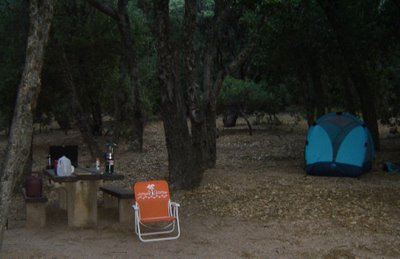Common Yellowthroat [
Geothlpis trichas]
 Photo from: http://www.notason.com/oiseaux/id329.htm
Photo from: http://www.notason.com/oiseaux/id329.htm
It’s sort of a Black-eyed Susan: widespread and so common they made that part of its name. But the flower and the bird are two of my favorites, in large part because they’re commonplace. Why should beauty be rare?
This early migrant is among our first, a few arriving in late August (most by mid-September) and staying through October in areas of high pasture. The bird is also one of the first I find dead beneath the big glass windows on campus. Once after picking one up, I described it as “a gaudy jewel, the sort of bird any native might be proud to wear around his neck. The bird bears two or three distinct hues from chin to vent, shades of yellow-green and maybe orange…Topside it's all olive-moss-pistachio and good enough to eat.”
A few days later my hunting journal notes, “The yellowthroats are still in town. The hay field last night was full of them. They travel in pods, lifting from seed-heavy stalks of Johnsongrass in threes and fours to fly maybe thirty yards to another patch...At the end of the line, a dozen can break out, shifting fast for other cover. Their little olive backs blur well with the ground. Blink, and you lose them."
I wondered then, as now, Where do they go when the mowers mow? “Some may fly across the levee to the marsh or else keep moving south. Those who stay play musical chairs in the shrinking prairie—odd ones out feeding Cooper's hawks and house cats.”
Gray catbird [
Dumetella carolinensis]
 Photo from: http://docern.blogspot.com/2005_09_01_docern_archive.html
Photo from: http://docern.blogspot.com/2005_09_01_docern_archive.htmlCatbirds are not common in my area. A friend told me
George Lowery found twelve nests here in twenty years, which I believe but can’t confirm. Lowery would have been looking long before the Age of Development, so whether suburbs are good or bad for Catbirds I don’t know. I can guess.
I do find them dead during migration. Another victim of the Big Window prompted this journal entry from October 13, 2003: “A gray catbird lay beneath the window wall this morning, shy of his destination. Steve Cardiff at the Museum of Natural Science tells me it's peak season for catbirds, most of them bound for South America via trans-Gulf crossing…This catbird is a study in what can be done with the color gray. Shades of charcoal, darkest in a streak atop his head, turn to lead and nickel, then to black again. From below, he's a somber blue-gray, the color of Gulf waters under storm. The crimson patch beneath his tail stands out like a warning flag at dusk: ‘Detour—Southbound Route Closed.’”
Loggerhead shrike [
Lanius ludovicianus]
 Photo from: http://www.birdsasart.com/loggerhead%20shrike.jpg
Photo from: http://www.birdsasart.com/loggerhead%20shrike.jpg“Butcherbird:” a great old name for our little backyard bandit. Only half-again the size of a house sparrow, the Loggerhead shrike
eats house sparrows. How cool is that? Shrikes attack and pursue active, vertebrate quarry (other birds in flight, small rodents, lizards and snakes), creating a new kind of animal: the “passerine raptor.” What they lack in a hawk’s grasping feet, they make back with a wicked, notched bill and a wonderful habit of hanging meat on a stick to eat it.
After leaving Florida for Louisiana, I still felt the rhythms of biological fieldwork: spotting birds and habitats, walking woodlots, scratching notes in code, and driving…driving! I needed a fix, but something I could do after office hours (there proved no market here for unlettered field biologists). My answer came from atop a young Live Oak near home—“
BZZZzzzzzT! BZZZzzT!”— A male shrike, calling, with wife and kids below in a little round nest made of twigs and trash.
By the time my own kids arrived, three summers later, I had dozens of nests located, hundreds of hours of observation logged and thousands of probably useless points of datum coded: diet, productivity, fledging dates. Anecdotal evidence I’ll be presenting for years over pizza and beer…
But there is always value in watching. If you don’t watch, you can’t see.


















































